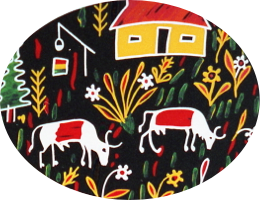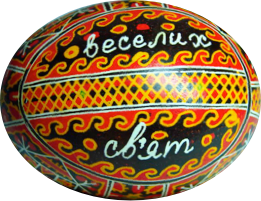Hutsul Pysanky
Гуцульські Писанки
Hutsul Pysanky
Гуцульські Писанки

Hutsul pysanky are distinct for the intricacy of their designs, which is actually a fairly recent development. Hutsul pysankarky began selling their pysanky in the 1800s, first locally, and then eventually in many cities in the Austro-Hungarian empire. The more intricate pysanky sold better, so they began to create more and more of them, and now those designs predominate.

Hutsul pysanky exhibit several other characteristics. The use of animal motifs is more common here than in other regions. You will often see birds, fish, deer and horses on Hutsul pysanky; the latter two are sun symbols–our ancestors believed that either a stag or a horse carried the sun across the sky–and are seen only on Hutsul pysanky.

Hutsul pysanky are also known for their use of resheto (cross-hatching); in most other regions, solid colors or stripes are more commonly used as “fill.” This example from the village of Stari Kuty, illustrates the Hutsul use of resheto.

In several areas of Hutsulshchyna, village scenes can be found on pysanky, including those showing ordinary human figures (rather than supernatural beings). This may be a relatively recent development; such pysanky can be found in Binyashevsky’s work, but is rare in earlier collections.

The Hutsuls have a deep love of churches and chapels. Not only do they build lots of them–many Hutsul families have a small “kaplytsia” near their house–but they often portray them on pysanky, in various degrees of accuracy.

The late Eudokia Kushnierchuk, a noted Detroit area pysankarka, was born in Kosmach before WWII, and learned to write pysanky there. Her pysanky, written in the old Kosmach style, used the traditional Hutsul colors of yellow, orange, and dark brown, with occasional green highlights. Although she used modern aniline dyes, she stuck to the traditional colors.

In recent times, as Hutsul pysankary have switched to chemical dyes, and those of Kosmach have also switched to a brighter color palate, that of yellow, red, green and black. These modern “Kosmach” pysanky now flood the market, and are squeezing out the older forms.

Kosmach pysanky can be found at markets throughout Ukraine, much like Inca musicians can be found in just about any city square in the world. They have become ubiquitous, the default pysanka, squeezing out those from different regions. As they have been mass produced, the quality has suffered, too, with work being less meticulous.
Pysanky from other parts of Hutsulshchyna are still written by local pysankarky, many of whom sell them in their villages or in regional markets. Interest in such pysanky (below) has picked up, and they have begun making their ways into bigger cities at Easter.

Highland Pysanky

Back to Hutsul Home
Back to Carpathian Pysanky Home
Back to Regional Pysanky Home
Back to Traditional Pysanky HOME
Search my site with Google